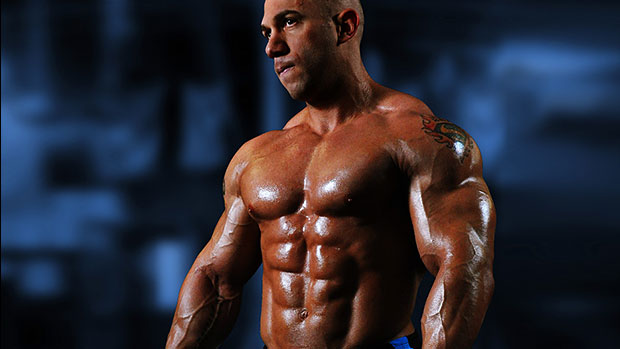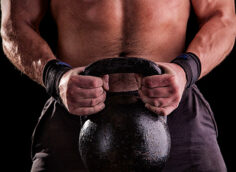Here's what you need to know...
- Master basic form and technique. Use full range of motion. When you get more advanced you can begin to bend those rules to increase intensity.
- You can push harder. When the pain becomes unbearable, the pro's are just getting started.
- Phil Heath has a coach. Jay Cutler has a coach. Amit Sapir has a coach. It doesn't make you inferior to have a coach. Get one.
- Master the Olympic lifts.
- Try to improve every workout, whether it's an extra set, more reps, more weight, or better technique. Over time you'll accumulate massive improvements.
I've been training for 20 years and to commemorate that long training slog, I sat down and compiled my 10 best training tips. After I wrote them down, though, I realized that while they'd no doubt be valuable to the novice trainee, they're probably things that the advanced trainee already knows. So I also compiled a second list to augment the first. The second list gives my best advanced tips. The end result is, I hope, something that's valuable to both levels of trainees.
1 – Learn Form and Technique
Novice Tip
The worst things I see in the gym include rounded backs during deadlifts, quarter squats, and partial pressing with no apparent reason.
Take the time to learn the movements and you'll set yourself up for a long career of continued success. Begin with body weight, then progress to a broomstick, and then work your way up to a bar. After that, keep feeding yourself more and more weight. If your technique isn't perfect with no weight, then it makes no sense to keep adding weight to the bar. Once your technique is perfected, the sky's the limit.
If your pattern of movement isn't right, then you won't be able to advance. You can't sprint before you walk, so learn to walk first! There's a lot of video material and information here on T Nation that will teach you the basics.
Advanced Tip
After you've learned and perfected your form and technique, you can use these techniques to make your training goal-oriented.
For example, if you want big quads, do more Olympic-style squats. If you want to gain strength, do more powerlifting-style squats. Likewise, do Olympic deadlifts for explosive power, regular deadlifts for strength, or sumo deadlifts to hit more of the glutes and hams.
2 – Learn the Basics
Novice Tip
Figure out how to do all variations of squats, deadlifts, rows, chin-ups, dips, and presses.
Learn them, and 70% of your battle's already been won. These basics are a must for any serious lifter/athlete to build a basic strength and physique base. Similarly, compound/multi-joint movements are always the "bread and butter" for every good training program – learn them, master them, repeat them, and improve them! Keep in mind that sometimes a workout of 10 sets of heavy deadlifts or squats will give you a better workout than any "fancy" leg/back session.
Advanced Tip
Now that you know the basics you can enhance them using endless types of tempo manipulation techniques in the compound movements.
Using these will make your exercises harder, more stimulating, muscle fiber-wise, and more interesting. For example: Do three 12-rep sets of squats. Do the first 4 reps using a pause at the bottom, then do the next 4 reps using a five-second negative. Finish the set up with 4 "normal" reps. Or do three 10-rep sets of chin-up. Do the first 5 reps with a 3-second pause at the top and a 3-second eccentric. Do the second 5 reps explosively.
3 – Build A Good Strength Base
Novice Tip
You won't build huge legs from squatting 135 pounds or build a huge chest from pressing pink dumbbells.
Of course, no one was born pressing 500 pounds or squatting 700 pounds – it takes time to build this kind of strength. Assuming your form/technique is in place, you'll want to incorporate some low reps and heavy weights into your program. For example, do 10 sets of squats for 3-4 reps each, or 8 sets of 5. In other words, in order to build strength, keep your weight heavy and use low reps for a high number of sets. Squatting your bodyweight is a bare-minimum requirement for a beginner (or twice your bodyweight for an intermediate-level lifter).
Advanced Tip
Once you've built your basic strength base, try changing your rep ranges of your compound movements every week.
Different ranges will keep your body guessing and stimulate your CNS, along with your muscles. This will also keep you from burning out. For example:
- Week 1: 10 sets x 3 reps
- Week 2: 8 sets x 5 reps
- Week 3: 6 sets x 8 reps
- Week 4: 2 waves 5/3/1
4 – Learn the Olympic Lifts
Novice Tip
Yes, they're frustrating, difficult, and take lots of time and patience to learn, but if you can master a clean and press, clean and split, and the snatch, then every other movement will be EASY because you've already mastered squatting, deadlifting, and pressing.
The benefits are explosive power, strength, flexibility, and coordination. Take time to learn these.

Advanced Tip
Once you've mastered these lifts, try and incorporate them into your workout at least three times a week.
They'll activate your CNS, give you a pump, and make you more mobile so that the rest of your workout will flow better and all of the exercises will feel "lighter" because you're going from a complex exercise to something a lot simpler. Try doing this at the start of back, shoulder, or leg workouts:
- Back: Start with cleans, 5 sets x 5 reps (any variation)
- Shoulders: Start with the power snatch, 6 sets x 3 reps
- Legs: Start with the full snatch, 3 sets x 5 reps
5 – Practice Full Range of Motion
Novice Tip
If you're healthy, always use a full range of motion, especially while doing the basic movements.
Squat all the way to the ground, touch the bar to your chest on bench presses and lock out fully, and do chin-ups all the way up and all the way down. Hypertrophy is much greater when you use a full range of motion as opposed to partial-range movements. I've been training this way since the beginning, thanks to being taught the basics from my Olympic lifting coaches. I've always done full ROM and I credit it, partly at least, with never having any serious injuries.
Advanced Tip
While full ROM is great, it's useful to try and extend your sets using partial-range movements, which are a good way to keep tension on the muscle and keep blood pumping to the area.
- Lifting in full range of motion = strength and mobility.
- Doing partial reps = better pump and hypertrophy.
For example, try these:
- EZ-Bar Biceps Curls (24 reps)
- 8 full reps
- 8 partial reps
- 8 bottom reps
- Bench Press (30 reps)
- 10 full reps
- 10 partial reps
- 10 forced reps
6 – Stay Flexible
Novice Tip
During my track and field days, I learned that the more mobility/flexibility I maintained, the less risk of injury I had.
Not only am I more functional in my day-to-day life from working on my flexibility, but my workouts are much more explosive. Try to do 5-10 minutes of dynamic stretching pre-workout, and 5-10 minutes static-stretching post-workout. It's time well spent.
Advanced Tip
As you grow, mobility and flexibility are sometimes compromised due to the added mass and normal stretching by itself isn't enough.
Try this at the beginning or end of the workout:
- Take an empty bar and hold it in an overhead squat position. Then sit down in the squat position and try to walk five steps forward and five steps backwards without the bar moving (or you falling over). This will improve shoulder flexibility and hip mobility.
- Lie on a bench and hold a dumbbell over your head. Then lower the dumbbell as if you were doing a pullover and hold it in the stretch position for 10-15 seconds. Repeat three times. The added weight helps shoulder flexibility. Use light weight, just enough to help the stretch.
7 – Change is Good!
Novice Tip
If you plan on training a long time, you'll want to change up the way you're doing stuff in the gym (stance, grip, angles, exercise variations, sets/reps, technique, etc.).
The key is to stimulate your body in different ways instead of doing the same thing over and over. You'll always need to do the basics in some form, but the way that you execute them needs to include variations. This is an excellent tool for progression in your training and overall physique.
Advanced Tip
Use giant sets and drop sets together.
It sounds a little crazy, but it'll definitely shock your body. Don't do it more than once every 2-3 weeks, though. Oh, and do it at the END of a workout.
- Chest Giant Set: 2-3 sets x 24 reps (drop set style):
- A1. Incline Hammer Press: 8/8/8
- A2. Machine Flies: 8/8/8
- A3. Decline Dumbbell Press: 8/8/8
See what's happening? You'll do 8 reps of incline hammer presses. Then, in drop-set fashion, you'll lower the weight so you can do 8 more reps. Lower it again so you can do a final 8 reps. Immediately go to machine flies where you'll also do 3 drop sets of 8. Follow those up with 3 drop sets of decline dumbbell presses. Each set ends up being 72 reps!
8 – It Takes Time!
Novice Tip
As they say, Rome wasn't built in a day.
Neither was Fresno, for that matter. The point is, you won't be Mr. Olympia, or break any world records, in just a year's time. Be realistic about the improvements you can make in a specific time frame. Likewise, give any program 8-12 weeks to see if it's working for you. Try to improve even 1% every workout, as any progression is good, whether it's an extra set, more reps, more weight, or better technique. Over time you'll accumulate massive improvements. Consistent improvement equals long-term gains. I've been training over 20 years and I'm still improving every workout.
Advanced Tip
In order to track progress, buck up and try a DEXA scan once a year.
It measures both body fat and your lean muscle mass, so you can truly tell what kind of progress you've been making.
9 – Train Harder
Novice Tip
You always think you're training hard... until you see someone train harder.
Believe me, whatever you're doing, you can do more. And no, you won't overtrain; you'll just advance faster when you push your limits. I used to think squatting 405 pounds for 10 reps was great. Now I can do 405 for 25 reps and it's okay, but I know I'm going to get up to 35 reps. Don't be afraid of more weight and more sets; just push a little more each and every workout (even adding 2.5 pounds is great). The greatest athletes in the world have done things that everyone thinks are crazy, but these are the same people breaking world records. Trust me, you can always do more. Train hard, train harder!
Advanced Tip
Every time you think you're training hard at the end of the set, ask yourself this hypothetical question: If someone were holding a gun to your head and demanding that you do one more set, one more rep, or just a little more weight, could you?
If the answer is yes then you can push harder. If the answer is no, then you know you've reached your limit.
So when you get to that point in your leg workout where you're completely dead but have to finish an insane drop set, then you need to go to the gun scenario. Would you finish the set if there were a gun pressed against your temple? Hell yes you would, so do the damn set! As an advanced lifter, it's not supposed to be easy or "fun" and you might even puke. Just man up, find your happy place and do your damn set!
10 – Find a Coach/Training Partner
Novice Tip
The biggest improvements in my career occurred while training with people who were more knowledgeable or stronger than me.
They simply pushed my limits. When you see someone do something better than you, it naturally pushes you to do better. Even today, I hate to see anyone lift more than me. I always want to beat them! Healthy competition is good, so surround yourself with successful people in your sport or profession and it'll force you to excel. There's always something new to learn and some new way to improve, so find someone and make him your training partner.
Advanced Tip
Phil Heath has a coach. Jay Cutler has a coach. I have a coach, along with a great training partner.
It doesn't make you inferior to have a coach. You can learn from them and they can learn from you. If I can learn one new thing every day from a client, a coach, an article, or a book, then it's a great use of my time and a successful day.





